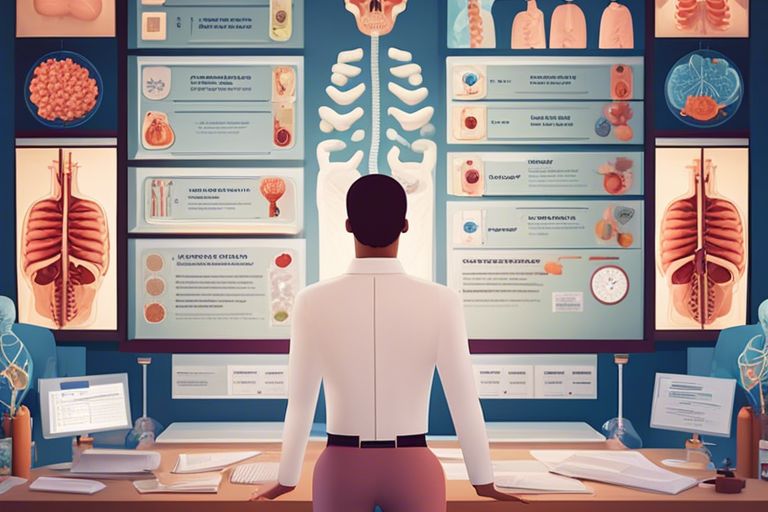Many aspiring medical professionals find endocrine anatomy to be a complex and challenging subject. Understanding the endocrine system is crucial as it plays a vital role in regulating various bodily functions such as metabolism, growth, and mood. In this beginner’s guide, we will break down the intricacies of the endocrine system and provide you with important tips to master this important aspect of human anatomy. By the end of this post, you will have a solid foundation in endocrine anatomy and be well-equipped to tackle more advanced concepts in the future.
Foundations of Endocrine Anatomy
Major Endocrine Organs
While studying endocrine anatomy, understanding the major endocrine organs is crucial. These include the pituitary gland, thyroid gland, adrenal glands, pancreas, and the ovaries and testes. These organs play vital roles in regulating various bodily functions through the release of hormones.
Hormones and Their Functions
For a beginner in endocrine anatomy, grasping the concept of hormones and their functions is fundamental. Hormones act as chemical messengers in the body, influencing metabolism, growth, energy levels, and reproduction. Each hormone has a specific function, and an imbalance can lead to various health issues.
With a proper understanding of hormones and their functions, individuals can appreciate the intricate balance required for the body to function optimally. Imbalances in hormone levels can lead to conditions such as diabetes, thyroid disorders, and reproductive issues. Being aware of these functions is important for diagnosing and treating endocrine disorders effectively.
Learning Strategies for Mastering Endocrine Anatomy
Visual Aids and Diagrams
Even as a beginner, grasping the complexities of endocrine anatomy can be made easier with the use of visual aids and diagrams. Anatomy charts, colorful illustrations, and interactive diagrams can help you visualize the location and function of each endocrine gland in the body. These tools can provide a clearer understanding of how hormones are produced, regulated, and interact within the endocrine system.
Interactive Learning Tools
Mastering endocrine anatomy involves utilizing interactive learning tools that offer a hands-on approach to studying the subject. Online quizzes, virtual anatomy models, and 3D interactive maps can enhance your learning experience by allowing you to test your knowledge in a dynamic way. This interactive engagement can help reinforce key concepts and improve retention of complex information.
Common Disorders of the Endocrine System
Symptoms and Diagnosis
For individuals experiencing hormonal imbalances, symptoms can vary depending on the specific disorder. Common signs include fatigue, weight fluctuations, mood changes, and irregularities in bodily functions. To accurately diagnose endocrine disorders, healthcare providers rely on a combination of thorough medical history, physical exams, and specialized tests such as blood tests, imaging studies, and hormonal level evaluations.
Treatments and Management
To effectively manage endocrine disorders, treatment plans are tailored to the specific condition and individual needs. Depending on the disorder, treatments may include hormone replacement therapy, medication to regulate hormone levels, lifestyle modifications, and in some cases, surgery. The goal of treatment is to restore hormonal balance, alleviate symptoms, and prevent complications.
The management of endocrine disorders requires a multidisciplinary approach involving endocrinologists, primary care physicians, and other healthcare professionals. Early detection and intervention are crucial in preventing long-term complications and improving the quality of life for patients with endocrine disorders. Regular monitoring and adjustments to treatment plans may be necessary to ensure optimal results and overall well-being.

Applying Knowledge of Endocrine Anatomy
Clinical Relevance
Now, let’s research into the clinical relevance of mastering endocrine anatomy. Understanding the intricate details of each endocrine gland and its associated hormones is crucial in diagnosing and treating a variety of endocrine disorders. Disruption in hormone levels can lead to a myriad of health issues such as diabetes, thyroid disorders, and adrenal insufficiencies. By applying your knowledge of endocrine anatomy, you can better comprehend the underlying causes of these conditions and provide more effective patient care.
Future Developments in Endocrinology
Knowledge of future advancements in endocrinology is necessary for staying at the forefront of medical practice. The field of endocrinology is rapidly evolving, with groundbreaking research leading to innovative treatments for hormonal imbalances and endocrine disorders. Keeping abreast of these developments can provide you with new diagnostic tools and treatment options to improve patient outcomes.
Developments: Stay informed about emerging technologies such as precision medicine and gene editing that are revolutionizing the way endocrine disorders are diagnosed and managed. Collaborating with multidisciplinary teams and attending conferences can enhance your understanding of these exciting advancements in endocrinology.
Final Words
As a reminder, mastering endocrine anatomy is crucial for understanding the intricate and complex hormonal system of the human body. By following this beginner’s guide, you can build a solid foundation of knowledge in this area and set yourself up for success in any healthcare or medical field. Remember to practice actively engaging with the material through study aids and interactive resources to cement your understanding. With dedication and perseverance, you will be able to confidently navigate the endocrine system and its functions with ease.
FAQ
Q: Why is mastering endocrine anatomy important?
A: Understanding endocrine anatomy is crucial as it helps in comprehending how different hormones regulate bodily functions and play a crucial role in maintaining homeostasis.
Q: What are the key components of the endocrine system that one should focus on?
A: The key components of the endocrine system include glands such as the pituitary, thyroid, adrenal, and pancreas, as well as hormones like insulin, cortisol, growth hormone, and thyroid hormones.
Q: How can beginners effectively master endocrine anatomy?
A: Beginners can master endocrine anatomy by studying the anatomical structures of endocrine glands, understanding the functions of hormones, and familiarizing themselves with the feedback mechanisms that regulate hormone secretion.